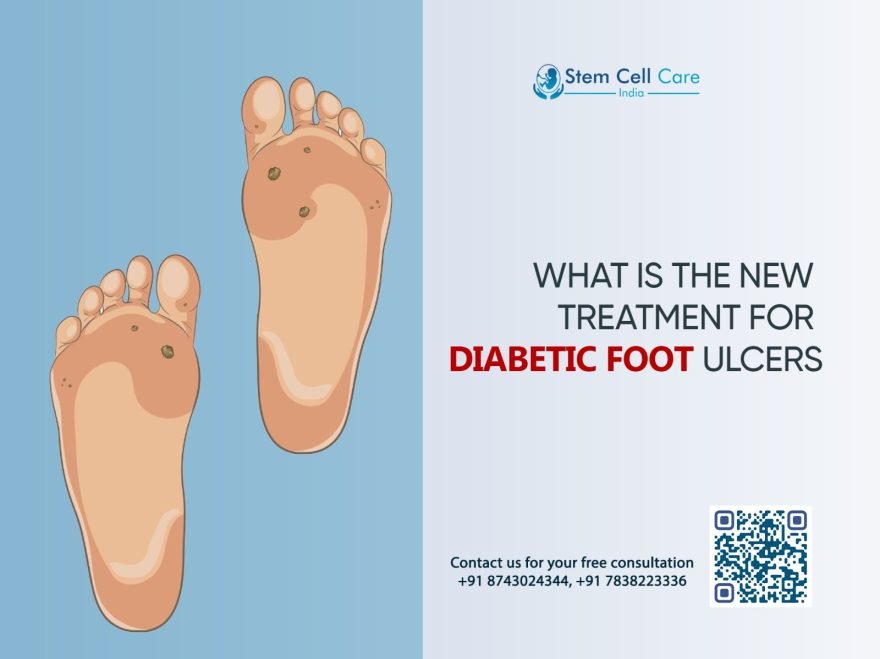Table of Contents
The common complication of diabetes happens to be through diabetic foot ulcers, resulting from extended periods of high blood sugar leading to poor circulation and nerve damage. The healing process here is usually slow or recurrent, with the application of regenerative medicine, stem cell therapy provides a newly emerging as well as revolutionary approach that utilizes the body’s healing powers by repairing tissues as a step toward better healing while holding new hope for persistent wounds.
How Do Diabetic Foot Ulcers Develop?
Diabetic foot ulcers are open sores or wounds, typically found at the bottom of the feet. They emanate from two main causes:
Peripheral Neuropathy: Diabetic nerve damage cuts off sensation to the lower extremities, leaving a person anesthetized to injury or pressure areas and hence unnoticed wounds.
Poor Circulation: Diabetic patients have blood vessels that are narrowed due to high sugar levels. Thus, tissues receive lesser amounts of oxygen and nutrients. The body cannot effectively heal minor injuries.
These ulcers, if left unchecked, can lead to infection, gangrene, or even amputation of the affected limb.
What is Stem Cell Therapy?
Some of the new medical treatments that can heavily rely on stem cells, especially those undifferentiated ones capable of transforming into any type of functional cell in regenerating tissues damaged by conditions with poor natural healing ability, include diabetic foot ulcers. Different sources such as bone marrow, adipose tissue, and umbilical cord blood can result in the origination of these stem cells. Following that, they are harvested for processing into implantation into the required affected areas, with stimulation of tissue regeneration.
How Does Stem Cell Therapy Work for Diabetic Foot Ulcers?
Stem cell therapy addresses the etiology of the mechanism of the pathological healing process with diabetic foot ulcers:
Angiogenesis: These stem cells have been known to induce the generation of novel vessels that help to be an improvement on flow and boost oxygenation at the wound site.
Anti-inflammatory Effects: Bioactive factors secreted by these stem cells act to reduce inflammation and thus create a healing-favorable environment.
Cellular Regeneration: The stem cells develop into skin and tissue cells that directly repair the affected area.
Immune Modulation: The effects of stem cells on the immune response are favourable to the healing process from infections and enhance the rate of wound healing.
Advantages of Stem Cell Therapy in Diabetic Foot Ulcers
Stem cell therapy has advantages over the traditional methods as listed below:
Non-Invasive: Stem cell therapy is less invasive compared to surgery. Recovery time and risks are highly minimized.
Cure the Root Cause: It heals the real causes of poor circulation and regeneration. Instead of subsiding symptoms, holistic healing results.
Reduces Amputation Risk: Because it heals ulcers thoroughly and effectively, it minimizes risks of complications and amputations.
Steps to Access Stem Cell Therapy for Diabetic Foot Ulcers
If you are interested in receiving stem cell therapy, here is how Stem Cell Care India can benefit you:
Consultation: They will allow a discussion of your condition and medical history with their experts.
Diagnosis and Assessment: Their team evaluates the severity of your diabetic foot ulcers and your general health.
Preparation for Therapy: Your required stem cells are isolated and prepared for the treatment.
Stem Cell Transplantation: The required stem cells are slowly injected into the affected area.
Follow-Up Care: Regular monitoring and support for tracking your healing progress.
Final Verdict
Diabetic foot ulcers are a serious matter that brings long-term complications and affects the patient’s quality of life. With stem cell therapy, faster and more effective healing is within your reach – a regenerative solution that can heal you. An expert in treatment and advanced treatment options, Stem Cell Care India is your trusted ally against diabetes-related complications. If you or a loved one is affected, discuss with them how you can transform your healing journey with stem cell therapy.


